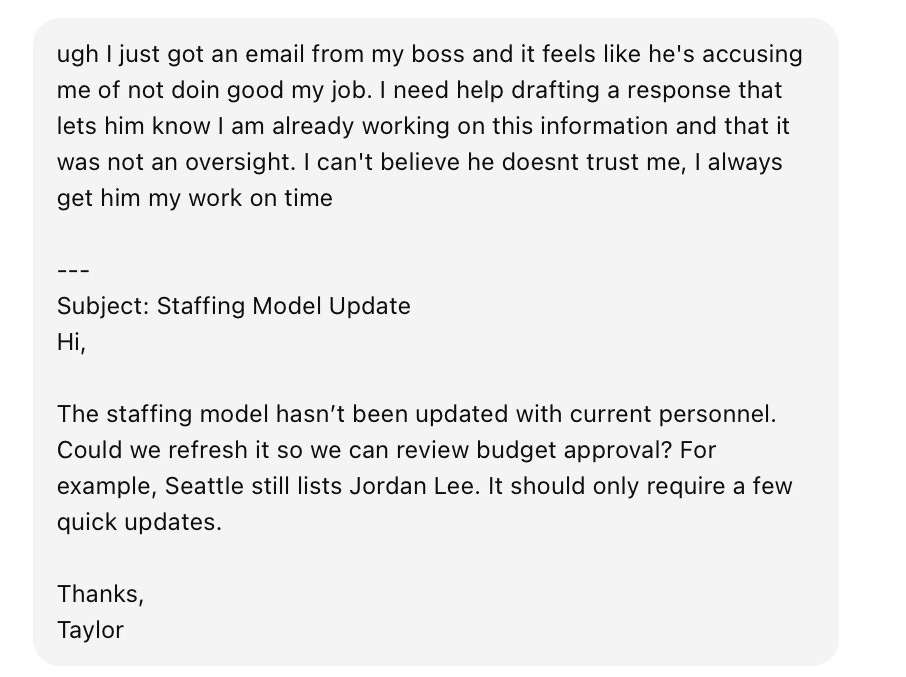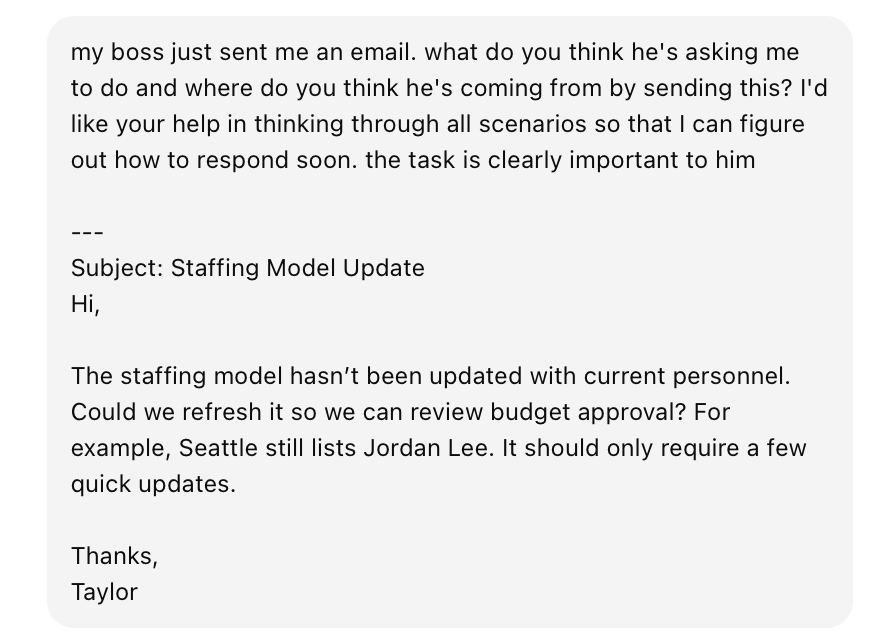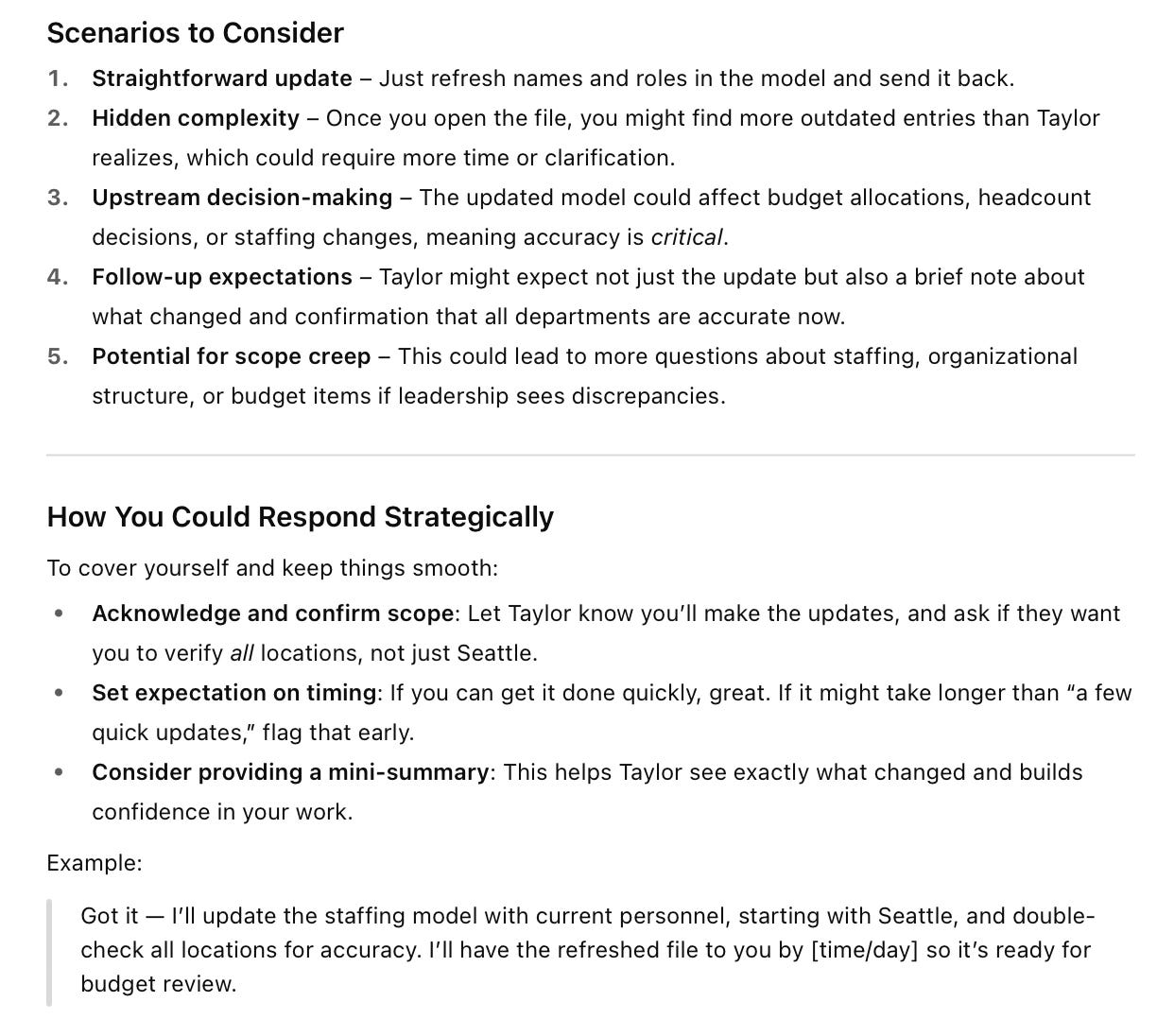This One Small Tweak Will Get You the AI Advice You Actually Need at Work
How to level up your AI use and receive tailored, high-value guidance. The tip that no one's told you yet.
Welcome to Reframed! I'm Ashley Rudolph and I write this newsletter for high-performers who want real, unfiltered advice about leveling up at work. My executive coaching clients and readers earn promotions, raises, and take on new challenges at work, with ease. Reframed readers describe my newsletter best:
“There's a depth here that I lack in many a Fast Co click bait article. You push beyond the superficial answers.”
One Thanksgiving morning I remember sitting in my mom’s house at the kitchen table taking a break from prepping for dinner. I opened my laptop and sitting at the top of my inbox was a message from my manager. Everyone was with their families and here they were, taking the time to reach out to me! I felt warm. Seen. Appreciated.
And based on my description, you’re probably assuming it was a long and specific email. That’s certainly how I remembered it: a long, thoughtful expression of gratitude. The kind you’d forward to a friend or save in a folder (which I did).
In doing my research for this post, I searched my inbox to find it again. And here’s what I found:
Have a wonderful day! I am very thankful to work with you.
One line.
Now, I’m not saying that the gesture was any less thoughtful — everything I said above is still true. But at the time, likely burned out, feeling under appreciated, and questioning my impact, it landed so much deeper.
My mind filled in the rest.
Emails have also had the opposite effect on me. Less warm and fuzzy, more like straight-up terror. I’d reread messages before sending, then again after, combing for mistakes.
And if I spotted a typo after hitting send?
I’d fire off an immediate apology, my body heating up as if I’d set something in motion I couldn’t undo.
My mind would race:
How could I be so careless?
What will they think?
I need to fix this right now.
Most of the time? The person on the other end didn’t even notice.
That’s the trouble with memory. It doesn’t keep the truth, it keeps your truth. And your truth is situational; shaped by context, emotion…a moment in time. Memories edit the past without asking, blending one moment into another until feelings overshadow the facts.
If you’re not attuned to what you’re feeling at work or how you’re processing a situation, you risk escalating tensions, misreading intentions, and making choices that don’t serve you.
And just like memory, AI will hold onto whatever version you hand it — whether it’s the warm, expansive one or the one that’s charged up.
THE CONTEXT: AI AT WORK
Behind the Headlines and Why This Conversation Matters
This brings me to AI use at work. If you’re like me, you’ve probably seen the headlines and dabbled with one or more of the tools out there. You may have read about the new ChatGPT-5 release (tweaked to reduce deceptive responses lol), the cautionary tales (AI triggering delusions — yikes!), and the growing number of people, including researchers, using AI as a brainstorming partner. Alongside those stories are warnings about AI’s environmental costs, quality concerns, and—more recently—AI sycophancy.
If you missed my Thursday newsletter last week, AI sycophancy is what happens when the bot you’re talking to acts like your “ride or die” friend — always agreeing with you, validating your point of view, and keeping the vibe positive (read more about it here).
At worst, AI tools can turn the very understandable human habit of reading into situations into a liability.
At best, it can be your biggest hype person, particularly when you need a boost.
If you’re leveraging AI at work, my advice for navigating it is to increase your awareness and to be clear on what you’re feeding your favorite tool, so that the outputs improve your outcomes and not fuel a spiral.
Let’s get into my recommendations for avoiding the sycophancy trap.
When Your Emotions and AI Sycophancy Collide
If you give AI your emotional state as fact, it won’t push back. Its default mode is not asking, “What else could be true here?” It will double down on your interpretation — even if that interpretation is wrong or needs to be interrogated further.
At work, that can lead to escalating tensions, misreading intentions, and making decisions that hurt your credibility.
The opposite is also true. Bring a balanced, objective prompt, and AI can be a sharp thinking partner — a computerized approximation of your most self-aware, sage friend.
On top of that, AI adoption is staggering, “half of Americans now use artificial intelligence large language models like ChatGPT, Gemini, Claude and Copilot”. That’s why this conversation is important, now.
If you’re a beginner, intermediate, or advanced AI user—you’ll want to keep reading.
MY EXPERIMENT: ONE EMAIL, TWO PROMPTS → TWO WILDLY DIFFERENT OUTCOMES
Here’s What The AI Sycophancy Trap Looks Like in Practice
I figured that showing you might be better than telling you. So I went back in my personal archives and found a real email from a former manager (note: names and locations have been changed) and decided to run a short experiment.
In my experiment, I set up a new ChatGPT account, devoid of my chat history, context, and preferences. I shared the email with ChatGPT from a place of frustration. Then, I shared it again in a different chat from a more clearheaded and objective place, not asking it to support my position and take action but asking it to help me think through all possible viewpoints.
The difference between the two prompts and ensuing responses? Mind-blowing.
The Experiment: My ChatGPT Messages and Responses
Here’s the email from my manager. For context: I don’t remember feeling defensive about it, but I think it’s a good example of correspondence that could have easily triggered defensiveness from a high achiever who cares about their reputation and doesn’t want to be perceived as slacking/not doing their work.
The email:
Subject: Staffing Model Update
Hi,The staffing model hasn’t been updated with current personnel. Could we refresh it so we can review budget approval? For example, Seattle still lists Jordan Lee. It should only require a few quick updates.
Thanks,
Taylor
Here’s what happened when I shared two different messages with ChatGPT about the email.
Scenario 1: Emotional Input
I started a chat in a tone that reflected what I might be thinking and feeling if my immediate reaction to this email was defensiveness. I wanted to come across as someone who felt frustration and self-doubt.
The vibe? “It feels like my boss is accusing me of not doing my job. I need help defending myself.”
Here’s what I put into ChatGPT:
Here’s how it responded:
The result?
A defensive, pointed draft based on the assumption that I’d been unfairly accused of not doing my work. The CYA vibe is strong but professional.
Language designed to prove I was already working on it, making it clear I hadn’t dropped the ball.
No attempt to explore what my manager might be thinking or to help me lower the emotional temperature.
ChatGPT took my assertions as fact and drafted an email based on those assumptions. As a result, I delegated my thinking, emotional regulation, and reasoning to a tool. IMO this type of use does not help you excel long term at work. It didn’t ask me a single question or try to help me explore alternatives but to be fair — it did offer to draft a warmer version at the very end of its recommendation. The goal was still to defend myself.
Scenario 2: Objective input
Next, I took the same email and tried my best to mimic what I might say when wanting to assess the scenario from a more objective POV, keeping the goal (getting the spreadsheet ready for planning discussions ASAP) as the primary focus.
The vibe this time? “Help me respond to this request professionally. I want to confirm my next steps, keep the tone constructive, and keep the request moving.”
Here’s what I put into ChatGPT:
Here’s how it responded:
This time, the output was completely different:
Clear and objective action steps, making the focus about the work without reading into the tone (tone can so easily be misread via email!)
A neutral, collaborative tone that reassured my manager I’d read and understood the request. While also providing built-in opportunities to confirm expectations and avoid misunderstandings.
It helped me understand where my manager might be coming from and what their priorities may be based on what was written in the email.
This response kept me focused on what I needed to do and gave my manager the benefit of the doubt. It didn’t only paint a rosy picture, notice how it highlighted the blindspots that they may have and how to navigate them. On top of that, it got me thinking about what types of requests may come next.
It also provided me with plenty to think about in terms of what headspace my manager might be in; helping me see that maybe this email wasn’t about mistrust or not having faith in my abilities at all, maybe it was just about making sure they were prepared for an incredibly urgent and important meeting.
When you see the two side by side, the contrast is stark.
Same original email.
Same AI tool.
The only difference was me— what I brought to the conversation.
THE FRAMEWORK: MY 3 STEP AI FRAMEWORK THAT WORKS WITH PEOPLE TOO
3 Tips for Using AI More Effectively at Work
You might be wondering, how can I use some of these insights moving forward? Here’s my 3 step formula if you’re using AI to navigate relationships at work. My primary advice when you’re having a tricky interpersonal issue is always “talk to them” but I do understand that sometimes people get swept up in the moment and need to diffuse. I also know that turning to ChatGPT may be easier than grabbing a colleague or friend, given that we live in a remote/hybrid work context.
Here’s my tips:
Give AI the situation without your emotional interpretation, then ask, “What else could be true here?” You can use the language I used in Scenario 2 as a starting point if you feel stuck.
Ask the AI for multiple perspectives before taking any action steps.
Do what I did. Compare an emotional prompt vs. an objective prompt to see the gap. Most importantly, think about how you want to approach your next steps.
I want you to remember that my advice above is more than AI skills, it’s just people skills in a different context.
The same discipline would apply when talking to a friend who’s venting about a fight they had with their boss, a colleague sharing the “real” reason a project is late, or a confidant filling you in on some behind-the-scenes drama. We’ve all been there — listening, getting riled up right alongside them — only to find out later that there was a whole other set of facts we didn’t know. And when the story changes, inevitably so does your opinion.
That’s why it matters to pause before you present your version of events — whether you’re telling it to a human or typing it into AI.
Ask yourself: Do I want to feel like I’m right or do I want to solve the problem?
Good luck! See you next week.
Ashley
Subscribe to Reframed.
Not subscribed yet? I share fresh leadership and career insights every Monday at 8AM, right before you tackle your week.
If you’re curious, people who work at Netflix, Google, Chanel, Meta, EY, Oracle, Deloitte, Bobbi Brown, and more subscribe to Reframed. Join them.










Featured this in today's leadership digest :) https://allisonstadd.substack.com/p/the-offbeat-106-lead-sheet-leadership